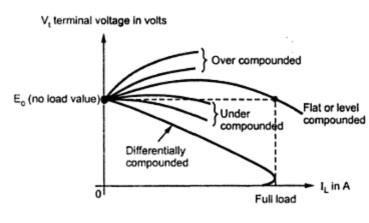The characteristics depends on whether generator is cumulatively compound or differentially compound generator. In cumulatively compound, Φ2r = Φ2r + Φ2r. As load current increases, Ia increases hence Ise also increases producing more flux. But as Ia increases, the various voltage drops and armature reaction drop also increases. Hence there is drop in the terminal voltage.
If drop in Vt due to increasing IL is more dominating than increase in Vt due to increase in flux then generator is called under compounded and its characteristics is dropping in nature, as shown in the Fig. 1.
 |
| Fig. 1 Characteristics of compound generator |
If drop in Vt due to armature reaction and other drops is much less than increase in Vt due to increase in flux then generator is called over compound and its characteristics is rising in nature, as shown in the Fig. 1. If the effects of the two are such that on full load current Vt is same as no load induced e.m.f. i.e. the effects are neutralizing each other on full then then generator is called flat compounded or level compound. Its characteristics is shown in the Fig. 1.
In differentially compound, ΦT = Φsh ~ Φse.. The net flux is difference between the two. As IL increases, Φsh is almost constant but Φse increases rapidly. Hence the resultant flux ΦT reduces. There is drop due to armature resistance, series field resistance, armature reaction due to which terminal voltage drops further. Thus we get the characteristics of such differentially compound generator as shown in the Fig. 1.
Comments
Post a Comment
Comment Policy
We’re eager to see your comment. However, Please Keep in mind that all comments are moderated manually by our human reviewers according to our comment policy, and all the links are nofollow. Using Keywords in the name field area is forbidden. Let’s enjoy a personal and evocative conversation.